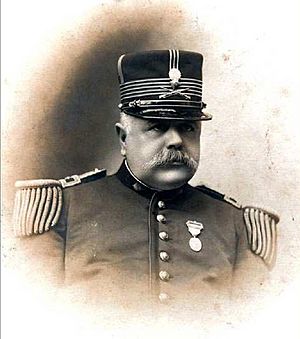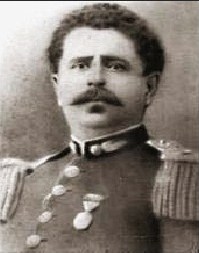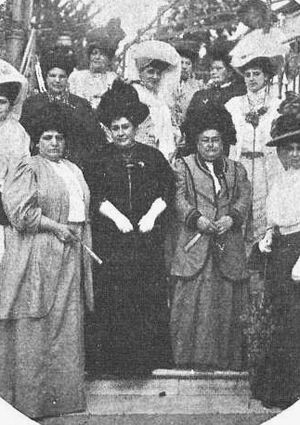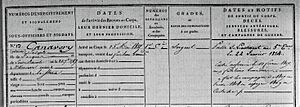Ángel Canavery facts for kids
Quick facts for kids
Ángel Canavery
|
|
|---|---|

Tcnel. Ángel Mateo Canavery
|
|
| Agregado Militar in the Kingdom of Italy | |
| In office 1889–1890 |
|
| Preceded by | ? |
| Succeeded by | ? |
| Jefe del Detall of the Estado Mayor General del Ejército | |
| In office 1897–1898 |
|
| Preceded by | ? |
| Succeeded by | ? |
| Personal details | |
| Born |
Ángel Mateo Canavery Castillo
21 September 1850 Buenos Aires |
| Died | 20 July 1916 (aged 65) Buenos Aires |
| Resting place | Recoleta Cemetery |
| Political party | National Autonomist Party |
| Spouse | Mercedes Montero Rondó |
| Children | María Esther Canaveri (goddaughter) |
| Signature | |
| Military service | |
| Allegiance | |
| Branch/service | |
| Years of service | 1870-1905 |
| Rank | Lieutenant colonel |
| Unit | Regimiento de Infantería de Línea Nº 1 |
| Battles/wars | Jordanist Rebellion Conquest of the Desert Revolution of 1880 Revolution of the Park |
Ángel Mateo Canavery (1850 - 1916) was an important Argentine military officer. He is known for his role in the Conquest of the Desert. This was a series of military campaigns in Argentina during the late 1800s. He also took part in conflicts against rebel groups. These included the Jordanist Rebellion and the Revolution of the Park.
Canavery also worked in important administrative roles. He served in the General Staff of the Army. He was also a military representative in Italy for a time.
Contents
Ángel Canavery was born in Buenos Aires in 1850. His parents were Tomás Canaverys and Macedonia Castillo. His family had roots from France or Ireland. He went to school in Buenos Aires.
Starting His Military Career
Canavery began his army journey in 1873. He started as a second lieutenant in the 8th Infantry Battalion. He served under Lieutenant Colonel Tomás Elliot. He helped finish the campaign against Ricardo López Jordán in Entre Ríos.
After this, he worked at the military base in Mercedes. In 1875, he left the army for a short time. He rejoined the army in 1876. He then served in forts like General Lavalle and Puan.
Campaigns in the Desert
By 1877, Canavery was a first lieutenant. He joined the 1st Line Regiment. He served under famous generals like Julio Argentino Roca. He took part in military trips against different tribes. These included attacks on the tribe of Catriel in "Treyco Grande" in La Pampa.
He also joined operations against the tribe of Namuncura. This was in a place called Chiloé, also in La Pampa. In 1878, he fought in the Battle of Hucal Grande. This battle was against the tribes of Cañumil and Huenchuquil.
In December 1878, he was part of battles against Namuncura's tribe. These fights happened in Lihué Calel. In 1879, he worked at the base in Choele Choel. He also joined General Roca's actions along the Río Negro river.
Canavery treated the Indigenous leaders with respect. He even received a special poncho from Chief Catriel.
Rising Through the Ranks
After his service in the south, Canavery returned to Buenos Aires. He was promoted to captain in April 1880. A year later, he worked in Salta until 1882. He then served in the Infantry Inspection.
In 1886, he became a major. In 1889, he was appointed as a Military attaché in Italy. This meant he represented the Argentine military there. He came back to Argentina in 1890. He was promoted to lieutenant colonel that August. He then served in the General Staff of the Army.
From 1892 to 1895, Canavery led military groups. He was in charge of detachments in Santa Catalina, Córdoba, and San Luis. In 1896, he joined the Active General Staff.
Facing Civil Conflicts
Canavery also helped in conflicts within Argentina. These included the Revolution of 1880 and the Revolution of the Park. He fought in major actions against the rebel forces. In 1897, President José Evaristo Uriburu appointed him. He became the Head of Detall for the 1st Argentine Army Corps.
In the late 1800s, the Argentine army updated its weapons. Soldiers started using modern Remington rifles. They also used carbines and Lefaucheux pistols. Canavery used these modern weapons during his time in the army.
He also attended social events with important people. He was a member of the Club del Progreso. This was the first gentlemen's club in South America. Ángel Canavery retired from the army in 1905. He had served for 35 years.
His Family and Legacy
Ángel Canavery married Mercedes Montero on April 3, 1880. They were married in the Basílica Nuestra Señora del Pilar church. Mercedes came from a well-known family. Her family was connected to José Rondeau.
Mercedes was very active in charity work in Buenos Aires. She was the president of the Sociedad Protectora de Huérfanos de Militares. This group helped orphans of military members. It was founded in 1891.
Notable Relatives
Ángel had several brothers. One was Colonel Tomás Canavery. He was a hero in the Battle of Lomas Valentinas during the Paraguayan War. His nephew was General Enrique Mosconi Canavery. Enrique even spent a short time in the German Army.
Many of Ángel Canavery's relatives served in the army. They fought in important historical events. These included the English invasions and the Argentine War of Independence. They also fought in civil wars in Argentina and Uruguay.
His grandfather, Mariano Canaverys, was also a soldier. He was a lieutenant in the Hussars of Pueyrredón. He helped defend Buenos Aires during the English invasions. Other Canavery family members served in the French Army during the time of Napoleon. Joseph Canavery, for example, was a rifleman from Italy.
Ángel Canavery worked with many famous Argentine officers. These included Carlos O'Donnell and Carlos Smith. In 1902, he attended the funeral of Lieutenant Colonel Juan de Dios Rawson.
Ángel and Mercedes did not have their own children. However, they were godparents to María Esther Canaveri. She was the daughter of their relatives, Saturnino and Carmen Canavery.
In 1906, the government allowed Lieutenant Colonel Ángel Canavery to travel to Europe. He likely went with his wife to cities like Marseille or Genoa.
Ángel Mateo Canavery Castillo passed away on July 20, 1916, in Buenos Aires. His wife, Mercedes Montero, died in the same city in 1930.
See also
 In Spanish: Ángel Canavery para niños
In Spanish: Ángel Canavery para niños




